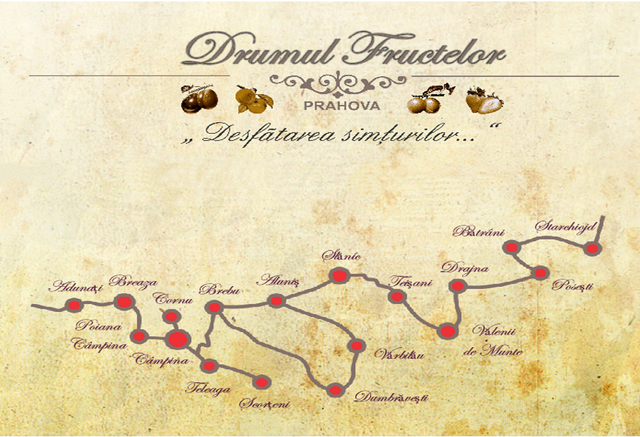The Fruit Route
We continue our travels as part of Radio Romania Internationals series of prize-winning contests “From the Wine Route to the Princes Route.

Ana-Maria Cononovici, 06.02.2014, 14:33
This time, the competition is dedicated to Prahova county, with its seat in the city of Ploiesti, inspired by three tourist promotion programs, the Fruit Route, the Wine Route and the Princes Route, all run by the Prahova County Council.
Today we invite you to take the Fruit Route, promoting the tradition of fruit growing area in Prahova County. Our guide is Mircea Cosma, head of the Prahova County Council, who told us how the idea of this route came about:
Mircea Cosma: “We thought of a package that would lead to better knowledge of tourism in Prahova County. This county only had roads from north to south, because this is how valleys flow from the Carpathians to the Danube, so we thought of building roads from east to west, linking the rich areas of Prahova County. There is a road in the hilly area, from Starchiojd to Valenii de Munte, going to Slanic, crossing the mountains, going to Breaza and to Adunati, on the border with Dambovita county. This is where we envisaged the Fruit Route. It is an area rich in fruit, proof of that being the fact that a large Polish company making natural fruit juices made here the biggest Polish investment in the country, in the town of Valenii de Munte, in order to capitalize on this rich resource. The Fruit Route was created for visitors to learn about this old traditional occupation. Romanians have been growing fruit in this area for ever, the hills are perfect for this.”
Since we were in Valenii de Munte, a well-known fruit growing area in the county, we spoke with Andrei Nicolae, councilman of the town:
Andrei Nicolae: “Welcome to Valenii de Munte. The Fruit Route project is part of a larger project run by Prahova County, alongside the Wine Route and the Princes’ Route. The Fruit Route links areas with tradition in fruit growing and processing. In Valenii de Munte we have a festival of homemade fruit brandy, at the end of October, each year, when fruit growers, as well as makers of preserves and brandies get together to promote and sell their traditional products. The other towns and villages in the area each have their own specificity, they have a festival of mountains, a festival of local flowers, all linked to traditional occupations in the Teleajen Valley, and this route of fruit.”
Valenii de Munte, with deep roots in history, has been, in turn, seat of its county, a customs town, a fair, the political center of its district, and the Teleajen culture capital. Valenii de Munte was also the summer residence of the famous historian Nicolae Iorga, and his memorial house can be visited here. You can also visit here the Teleajen Valley Ethnography Museum, the Plum Growing Museum of Natural Sciences, and the Queen Marie Museum of Religious Art.
Andrei Nicolae tells us about the most important fruit grown in this area:
Andrei Nicolae: “In this area, Valenii de Munte and Teleajen Valley, we grow plums, of many varieties. Many of the locals have orchards where they grow plums and apples. Some are used for preserves, some for making brandy, some are stored for the winter to make various other products. The plum is the main fruit grown here.”
Along the Fruit Route you can also visit various monuments, and can enjoy the many fruit products made by the locals. We asked councilman Andrei Nicolae to mention the most important tourist sites on the Fruit Route:
Andrei Nicolae: “We start from Adunati, Cornu, Brebu, Alunis, Scorteni, then, on the other side of the valley we get to Varbilau, Valenii de Munte, Teisani, Posesti, which is famous for its aged plum brandy, down to the border with Buzau County. Each year, producers and growers from all these places get together in Valenii de Munte to celebrate plum and brandy. Each place has special markers as part of this route, and each has it monuments of religious and lay art which can be visited and recognized by its marking.”
Tourists from all over the world are eagerly awaited in Prahova County, on the Fruit, Wine or Princes’ routes, each clearly marked. By tradition, Valenii de Munte is an area with many visitors from places that the town is twinned with, says Andrei Nicolae:
Andrei Nicolae: “We have tourists from all over Romania and from abroad. Valenii de Munte is twinned with Cimislia, from the Republic of Moldova, so we have a lot of Moldovan visitors. It is also twinned with Serbia, and Serbian Banat, and a lot of people come from there to attend classes at the Summer University. We have many visitors from Poland, Italy, and especially France, because we are twinned with the town of Eaubonne. You are eagerly awaited at any time of the year in Valenii de Munte, where we would like to introduce you to the traditions and culture of this area.”






























